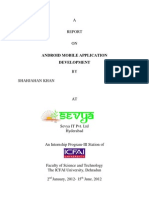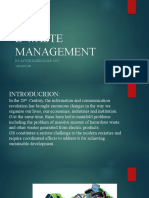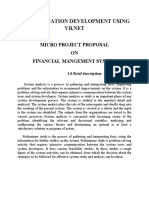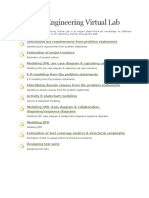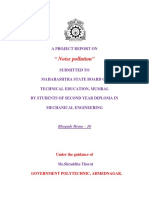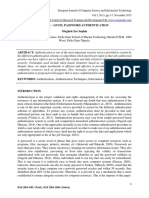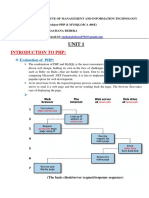0 ratings0% found this document useful (0 votes)
219 viewsMicro Project: Government Polytechnic, Vikramgad
Micro Project: Government Polytechnic, Vikramgad
Uploaded by
Dibyas Sanjay DubeyMicrofinancing has positively impacted women entrepreneurs in India. It has empowered women and improved their families' standards of living by providing small loans, savings programs, and financial services that were previously inaccessible. These programs have allowed women to start their own small businesses and generate income. However, women entrepreneurs still face socio-cultural barriers and lack access to capital, education, and resources compared to men. Increased access to microfinancing has helped boost women's participation in entrepreneurship.
Copyright:
© All Rights Reserved
Available Formats
Download as PDF, TXT or read online from Scribd
Micro Project: Government Polytechnic, Vikramgad
Micro Project: Government Polytechnic, Vikramgad
Uploaded by
Dibyas Sanjay Dubey0 ratings0% found this document useful (0 votes)
219 views11 pagesMicrofinancing has positively impacted women entrepreneurs in India. It has empowered women and improved their families' standards of living by providing small loans, savings programs, and financial services that were previously inaccessible. These programs have allowed women to start their own small businesses and generate income. However, women entrepreneurs still face socio-cultural barriers and lack access to capital, education, and resources compared to men. Increased access to microfinancing has helped boost women's participation in entrepreneurship.
Original Title
Ede Microproject
Copyright
© © All Rights Reserved
Available Formats
PDF, TXT or read online from Scribd
Share this document
Did you find this document useful?
Is this content inappropriate?
Microfinancing has positively impacted women entrepreneurs in India. It has empowered women and improved their families' standards of living by providing small loans, savings programs, and financial services that were previously inaccessible. These programs have allowed women to start their own small businesses and generate income. However, women entrepreneurs still face socio-cultural barriers and lack access to capital, education, and resources compared to men. Increased access to microfinancing has helped boost women's participation in entrepreneurship.
Copyright:
© All Rights Reserved
Available Formats
Download as PDF, TXT or read online from Scribd
Download as pdf or txt
0 ratings0% found this document useful (0 votes)
219 views11 pagesMicro Project: Government Polytechnic, Vikramgad
Micro Project: Government Polytechnic, Vikramgad
Uploaded by
Dibyas Sanjay DubeyMicrofinancing has positively impacted women entrepreneurs in India. It has empowered women and improved their families' standards of living by providing small loans, savings programs, and financial services that were previously inaccessible. These programs have allowed women to start their own small businesses and generate income. However, women entrepreneurs still face socio-cultural barriers and lack access to capital, education, and resources compared to men. Increased access to microfinancing has helped boost women's participation in entrepreneurship.
Copyright:
© All Rights Reserved
Available Formats
Download as PDF, TXT or read online from Scribd
Download as pdf or txt
You are on page 1of 11
MAHARASHTRA STATE BOARD OF TECHNICAL EDUCATION
GOVERNMENT POLYTECHNIC,
VIKRAMGAD
MICRO PROJECT
ACADEMIC YEAR:-2021-22
TITLE OF PROJECT
THE IMPACT OF MICRO FINANCING ON THE
PERFORMANCE OF WOMEN ENTERPRENEURS.
PROGRAM :- ENTERPRENEURSHIP CODE:-22032
DEVLOPMENT
COURSE:- MECHANICAL ENGINEERING DATE:-
GROUP DETAILS:-
NAME ROLL NO ENROLLMENT SEAT NO
NO
VIRAJ NAIK 3412 1915470050
MANISH 3413 1915470051
PATIL
HARDIK 3414 1915470052
BHOIR
SAHIL 3415 1915470053
DESHMUKH
SUBJECT TEACHER:- Mr. S.M.Saryam
SIGN:-
Impact of Microfinance on Women Entrepreneurship
Abstract
Micro Finance is growing as a powerful instrument for poverty
alleviation in the new economy. A majority of the microfinance
programmes has come up with the clear goal of reducing poverty
and empowering women. In addition, an increasing number of
microfinance institutions (MFIs) prefer women members as they
believe that they are more responsible and trustworthy.
Microfinance programs like the Self Help Bank Linkage Program in
India have been progressively promoting for their positive economic
impact and the belief that they empower women The SHG
Programme has come up with a new system of saving and lending
that is group lending and liability as a way of delivering microfinance
to its predominantly female members. Research has shown that
investing in women offers the most effective means to improve
health, nutrition, hygiene, and educational standards for families and
consequently for the whole of society. Thus, a special support for
women in both financial and non - financial services is necessary.
Many leading public and private sector banks are offering schemes
exclusively designed for women to set up their own ventures. Even
the unorganized sector has been heading into microfinance
movement. The present work is an attempt to study the role of
microfinance as an effective instrument in promoting women
entrepreneurship in India.
Introduction
Ashok K. Pokhriyal,, Rekha Rani,, Jaya Uniyal (2014) mentioned
in their study that Working women contribute to national
income of the country and maintain a sustainable livelihood of
the families and communities, throughout the world. As they
face many socio- cultural attitude, legal barriers, lack of
education and personal difficulties. Traditionally, women have
been marginalized. They are rarely financially independent and
often they are more vulnerable members of society. About 70%
of world’s poor are women. Yet they have no access to credit
and other financial services. Therefore, microfinance often
target women. Microfinance is a critical tool to empower
women from poor household. So, particularly women can get
benefit from microfinance institutions as many microfinance
institutions target only women, to empower them. Here in this
paper a small effort has been made on the empowerment of
women through the tool Micro-finance.
The term micro finance is of recent origin and is commonly use
d in addressing issues related to poverty alleviation, financial
support to micro entrepreneurs, gender development etc.
There is, however, no statutory definition of micro finance. The
taskforce on supportitative policy and Regulatory Framework
for Microfinance has defined microfinance as “Provision of
thrift, credit and other financial services and products of very
small amounts to the poor in rural, semi - urban or urban areas
for enabling them to raise their income levels and improve
living standards”. The term “Micro” literally means “small”. But
the task force has not defined any amount. However as per
Micro Credit Special Cell of the Reserve Bank Of India.
All over the world, the significant of women entry into the
workforce over the past three decades has produced profound
transformations in the organization of families, society, the
economy, and urban life. Since the late 1950s, women's
economic activities have been steadily increasing.
Women have always actively participated in their local
economies . In Africa, for example, women produce 80 percent
of the food and in Asia 60 percent and in Latin America 40
percent. In many cases, women not only produce the food but
market it as well, which gives them a well-developed
knowledge of local markets and customers.
This is a small example of the importance of women's work in
society. It does not illustrate the real extent of women's
contribution, especially in developing countries, not only to the
labour force, but also their role as a significant income-source
for the family.
Women, especially poor mothers, must divide their time
between work "productive role" and family "reproductive role",
and balancing all the demands. Time is valuable for these
women, as their livelihoods depend largely on their abilit y to
fulfil the multiple demands of the household and the
marketplace.
In spite of the remarkable importance of women's
participation, their jobs have been considered as an "extra
income" to family survival or simply to improve its living
conditions. Moreover, microenterprises owned by women have
been considered as a way to meet primary needs instead of a
profitable source of income.
Role of Microfinance in Women Entrepreneurship
Although men, as well as women, face difficulties in
establishing an additional enterprise, women have barriers to
overcome. Among them are negative socio - cultural attitudes,
legal barriers, practical external barriers, lack of education and
personal difficulties.
In spite of this, for women and especially for poor women,
microenterprise ownership has emerged as a strategy for
economical survival. One of the most essential factors
contributing to success in micro entrepreneurship is access to
capital and financial services. For various reasons, women have
had less access to these services than men.
In this context, credit for microenterprise development has
been a crucial issue over the past two decades. Research has
shown that investing in women offers the most effective means
to improve health, nutrition, hygiene, and educationl standards
for families and consequently for the whole of society. Thus, a
special support for women in both financial and non-financial
services is necessary.
Regarding limited-access to financial services, women depend
largely on their own limited cash resources or, in some cases,
loans from extended family members for investment capital.
Smaller amounts of investment capital effectively limit women
to a narrow range of low-return activities which require
minimal capital outlays, few tools and equipment and rely on
farm produce or inexpensive raw materials.
In general, women need access to small loans (especially for
working capital), innovative forms of collateral, frequent
repayment schedules more appropriate to the cash flows of
their enterprises, simpler application procedures and improved
access to saving accounts.
Surveys have shown that many elements contribute to make it
more difficult for women in small businesses to make a profit.
These elements are:
• Lack of knowledge of the market and potential profitability,
thus making the choice of business difficult.
• Inadequate bookkeeping.
• Employment of too many relatives which increases social
pressure to share benefits.
• Setting prices arbitrarily.
• Lack of capital.
• High interest rates.
• Inventory and inflation accounting is never undertaken.
• Credit policies that can gradually ruin their business (many
customers cannot pay cash; on the other hand, supplier s are
very harsh towards women).
Banking sector has been emerging in a big way to participate in
the microfinance movement. At present many commercial
banks are taking much interest in developing schemes
exclusively for women. Various leading public and private
sector banks have been providing finance under different
schemes to the women entrepreneurs with a relief in interest
rate on credit. Some of these schemes are listed in below.
With the support of Government and Public Sector organisation
Women entrepreneurship is growing at a rapid rate in the
world. The factors influencing these women across sectors
globally are opportunities created by globalisation, integrated
markets and jobs, support from the family, major support from
the government through various programmes started
internationally and domestically for women entrepreneurs,
improvement in their standards, and health and education.
This includes rise in income, self worth, self confidence and
social status in life. Due to empowerment and motivation,
women entrepreneurs create employment for many more
women in the communit y and in a country. Then only a
country will be considered inclusive. The number of female -
owned enterprises is growing at a faster pace than that of male
counterparts.
In India, women entrepreneurs identified majorly with micro,
small and medium enterprises because many women start their
enterprises with a very low net worth (low budget enterprise)
and ensure low risk. Therefore, women participation as per
revenue is less due to the size of their enterprises, but create
more volume and employment in various sectors (Annual
report of MSME 2012 –13) (Figure 3). As per the fourth All India
census of MSME, the number of women enterprises in the
registered sector are 2.15 lakh (13.72 per cent) and
unregistered sector are 18.06 lakh (9.09 per cent) of the total
sectors. This figure clearly shows the number of women
enterprises that are under the unregistered sector. This
indicates that many women enterprises would start up their
enterprises if the government makes policies for unregistered
sector where more benefits can be reaped by women
entrepreneurs. They could get more opportunities and benefits
if they come under the registered sector.
The MSME sector contributes to 44.7 million enterprises. It
creates employment for more than 80million jobs, this being
the second largest after agriculture. It contributes 45 per cent
of the total industrial manufacturing and above 40 per cent of
India’s total exports. The microenterprise and micro -finance
widely accepted development strategy for poverty reduction.
This responsibility has been equally taken up by government,
commercial banks and civil society. The role of SHGs in
providing micro -finance has been enormous in last one
decade. Self help groups with micro finance are effective in
reducing poverty, empowerment women and creating self
sufficiency in rural development.
Karnataka, and Tamil Nadu are such examples where women
entrepreneurship and micro-enterprises have grown due to
extensive support of SHGs. They have provided micro-finances,
capacity building programmes by training women, and have
nurtured them with their financial support. Today, the reserve
bank of India (RBI) also understands the role and importa nce
of SHGs in financing, and has extended medium sized loans to
women entrepreneurs in support with NABARD. The beauty of
women entrepreneurs is the motivation for other women to
come up and participate with equal opportunities and maintain
their enterprises. Across the world maximum start ups have
failed due to financial problems faced by women
entrepreneurs, but today due to SHGs, trust has been built
amongst the women entrepreneurs to realize and make their
dreams come true. Therefore, this type of growth is truly an
inclusive growth in India.
Conclusion :-
Women entrepreneurship is both about women‟s position in
the society and about the role of entrepreneurship in the same
society. Women entrepreneurs face many obstacles,
specifically in marketing their product (including family
responsibilities), that have to be overcome in order to give
them access to the same opportunities as men. The entry of
rural women in micro - enterprises must be encouraged and
aggravated. Rural women can do wonders by their effectual
and competent involvement in entrepreneurial activities. The
rural women have the basic indigenous knowledge, skill,
potential and resources to establish and manage enterprise.
Now, the need is for knowledge regarding accessibility to loans,
various funding agencies, procedures regarding certification,
awareness on government welfare programmes, motivation,
technical skill l and support from family government and other
organisation.
You might also like
- No Nonsense Forex The Manual 1.0 June 2019: Please NoteDocument104 pagesNo Nonsense Forex The Manual 1.0 June 2019: Please NoteEleuterio Suerte86% (7)
- Sonatrach Communication - AnglaisDocument26 pagesSonatrach Communication - AnglaisikramghierNo ratings yet
- Mathematical and Statistical Methods For Actuarial Sciences and FinanceDocument465 pagesMathematical and Statistical Methods For Actuarial Sciences and FinanceaditeguhNo ratings yet
- Report On Android Mobile Application DevlopmentDocument69 pagesReport On Android Mobile Application DevlopmentShahjahan100% (2)
- Chapter 16 Managing Marketing ChannelsDocument9 pagesChapter 16 Managing Marketing ChannelsMandy00011123322No ratings yet
- Philips PCS 2000 Bucky - Service Manual PDFDocument32 pagesPhilips PCS 2000 Bucky - Service Manual PDFMuhammad Ahmad100% (1)
- Gad MicroDocument25 pagesGad MicroSandy Borale100% (1)
- Bank Management System: Maharashtra State Board of Technical Education, MumbaiDocument10 pagesBank Management System: Maharashtra State Board of Technical Education, MumbaisakshiNo ratings yet
- Software EngineeringDocument11 pagesSoftware EngineeringMahesh DarvankarNo ratings yet
- "Project Title": Diploma in Computer EngineeringDocument24 pages"Project Title": Diploma in Computer Engineeringpriyanka patilNo ratings yet
- Mad MicrprjctDocument19 pagesMad Micrprjct68 Nitesh PundgeNo ratings yet
- ETI Micro-Project Report SurajDocument23 pagesETI Micro-Project Report SurajMorris jonsonNo ratings yet
- Ste Micro-ProjectDocument8 pagesSte Micro-Projecthamza khanNo ratings yet
- Eti 6th Sem MicroprojectDocument9 pagesEti 6th Sem MicroprojectRushikesh Patil50% (2)
- Css Micro ProjectDocument15 pagesCss Micro ProjectShree M KNo ratings yet
- DCC MicroproDocument10 pagesDCC Microprosahil shaikh50% (2)
- Annexure I: SR - No Student Name Roll NoDocument6 pagesAnnexure I: SR - No Student Name Roll No30 Om GhugareNo ratings yet
- Mad Micro ProjectDocument10 pagesMad Micro ProjectThe LooserNo ratings yet
- Final Project of GUI .PDF 2Document28 pagesFinal Project of GUI .PDF 2RahulNo ratings yet
- Title OF Micro ProjectDocument19 pagesTitle OF Micro ProjectRahulNo ratings yet
- DCC Unit 3Document66 pagesDCC Unit 3Raj DebadwarNo ratings yet
- Est Micro ProjectDocument13 pagesEst Micro ProjectJayesh gaming100% (1)
- MIC MicroprojectDocument30 pagesMIC Microprojectᴠɪɢʜɴᴇꜱʜ ɴᴀʀᴀᴡᴀᴅᴇ.No ratings yet
- Microproject DTMDocument10 pagesMicroproject DTMUnique TechnicalNo ratings yet
- Python MicroprojectDocument24 pagesPython MicroprojectSushant kakadeNo ratings yet
- Mic 22415pdfDocument11 pagesMic 22415pdfVikas NishadNo ratings yet
- Nis MicroprojectDocument19 pagesNis MicroprojectMinecraft VillagerNo ratings yet
- Java Programing MicroprojectDocument20 pagesJava Programing MicroprojectSaniya PuchalwarNo ratings yet
- Ajp Project (1) MergedDocument22 pagesAjp Project (1) MergedRohit GhoshtekarNo ratings yet
- Micro Project Report On: Food Ordering SystemDocument6 pagesMicro Project Report On: Food Ordering Systemsahil bhoir100% (1)
- Micro Project Report: " Climate Change An Global Issue. "Document13 pagesMicro Project Report: " Climate Change An Global Issue. "Assad Mujawar100% (3)
- Android Quiz App 22617 MADDocument19 pagesAndroid Quiz App 22617 MADSandip kotkarNo ratings yet
- Government Polytechnic, Jalna Computer Engineering DepartmentDocument16 pagesGovernment Polytechnic, Jalna Computer Engineering DepartmentVishwas LandgeNo ratings yet
- STE Software Testing 22518 Micro Project 5th Semester MSBTEDocument8 pagesSTE Software Testing 22518 Micro Project 5th Semester MSBTEtom444842No ratings yet
- Eti MicrprjctDocument14 pagesEti Micrprjct68 Nitesh PundgeNo ratings yet
- Study of Management Principles Applied To A Large Scale IndustriesDocument12 pagesStudy of Management Principles Applied To A Large Scale Industrieschavhan sayali dilip0% (1)
- CPP Project ReportDocument45 pagesCPP Project ReportLucky AnsariNo ratings yet
- EST MicroprojectDocument11 pagesEST Microproject2031 Ayush KshirsagarNo ratings yet
- Eti ProjectDocument29 pagesEti ProjectMinecraft VillagerNo ratings yet
- Rainwater Harvesting: Vivekanand Education Society PolytechnicDocument26 pagesRainwater Harvesting: Vivekanand Education Society Polytechnicsidhhart kunkololNo ratings yet
- Ste Software Engineer NotesDocument13 pagesSte Software Engineer NotesDhruv Gandhi100% (1)
- Certificate: Maharashtra State Board of Technical Education Mumbai Government Polytechnic, SolapurDocument15 pagesCertificate: Maharashtra State Board of Technical Education Mumbai Government Polytechnic, SolapurRitesh SulakheNo ratings yet
- Micro-Project Report ON ": "Student Information Management SystemDocument46 pagesMicro-Project Report ON ": "Student Information Management SystemAKASH THORATNo ratings yet
- Peer To Peer MicroprojectDocument17 pagesPeer To Peer MicroprojectSahil JadhavNo ratings yet
- A Micro-Project Report On "Small Scale Industry": Prof. Totare N.VDocument14 pagesA Micro-Project Report On "Small Scale Industry": Prof. Totare N.VRaven X Gaming50% (2)
- GUI MicroprojectDocument58 pagesGUI Microprojectgirish desaiNo ratings yet
- Sinhgad Technical Education Society'S: Write A Javascript Code To Create 3 Radio Buttons To Select Country NamesDocument13 pagesSinhgad Technical Education Society'S: Write A Javascript Code To Create 3 Radio Buttons To Select Country NamesPRABHAKAR MORENo ratings yet
- 1 Software Engineering Virtual LabDocument4 pages1 Software Engineering Virtual Labprince_kc2002No ratings yet
- Submitted in Partial Fulfillment of The Requirements For The Award of Diploma inDocument47 pagesSubmitted in Partial Fulfillment of The Requirements For The Award of Diploma inShekhar JadhavNo ratings yet
- D2 EdeDocument5 pagesD2 EdekaustubhNo ratings yet
- Environmental Studies ProjectDocument8 pagesEnvironmental Studies ProjectROYAL GAMER YTNo ratings yet
- Voice AssistantDocument46 pagesVoice Assistantvedantbhosale40No ratings yet
- Management MicroprojectDocument35 pagesManagement MicroprojectRP GraphicsNo ratings yet
- Thakur Polytechnic Diploma in Computer EngineeringDocument22 pagesThakur Polytechnic Diploma in Computer EngineeringParth MehtaNo ratings yet
- PHP ProjectDocument36 pagesPHP ProjectSandhya SalunkeNo ratings yet
- OSY Report 13Document11 pagesOSY Report 13Evan BoseNo ratings yet
- Three Level Password AuthenticationDocument7 pagesThree Level Password AuthenticationMoses KabeteNo ratings yet
- Tom ProjectDocument13 pagesTom ProjectGanesh GoreNo ratings yet
- ITR Report 06octDocument24 pagesITR Report 06octOm JoshiNo ratings yet
- Ajp ProjectDocument4 pagesAjp ProjectMISBAH NAIK0% (1)
- AJP MicroprojectDocument19 pagesAJP MicroprojectSaloni PatilNo ratings yet
- Sahil Java ProjectDocument19 pagesSahil Java ProjectMr ShubhamNo ratings yet
- Impact of Microfinance On Women Entrepreneurship in IndiaDocument12 pagesImpact of Microfinance On Women Entrepreneurship in IndiaSunitaNo ratings yet
- Microfinance and Women EmpowermentDocument6 pagesMicrofinance and Women EmpowermentRasel Talukder100% (1)
- New Syl RD Sem IVDocument4 pagesNew Syl RD Sem IVAbhay JadhavNo ratings yet
- Dibyas Validate MigrationDocument1 pageDibyas Validate MigrationDibyas Sanjay Dubey100% (1)
- Sample Policy Document - LIC S Cancer Cover - UIN - 512N314V02Document15 pagesSample Policy Document - LIC S Cancer Cover - UIN - 512N314V02Dibyas Sanjay DubeyNo ratings yet
- Report JavaDocument5 pagesReport JavaDibyas Sanjay DubeyNo ratings yet
- Maharashtra State Board of Technical Education: (AUTONOMOUS) (ISO 9001:2008) (ISO/IEC: 27001:2013)Document1 pageMaharashtra State Board of Technical Education: (AUTONOMOUS) (ISO 9001:2008) (ISO/IEC: 27001:2013)Dibyas Sanjay DubeyNo ratings yet
- CapDocument1 pageCapDibyas Sanjay DubeyNo ratings yet
- Java Assignment 1Document2 pagesJava Assignment 1Dibyas Sanjay DubeyNo ratings yet
- Be - Computer Engineering - Semester 3 - 2022 - December - Computer Graphicsrev 2019 C SchemeDocument1 pageBe - Computer Engineering - Semester 3 - 2022 - December - Computer Graphicsrev 2019 C SchemeDibyas Sanjay DubeyNo ratings yet
- Lokmanya Tilak College of Engineering, Navi MumbaiDocument1 pageLokmanya Tilak College of Engineering, Navi MumbaiDibyas Sanjay DubeyNo ratings yet
- Room Agreement GauravDocument3 pagesRoom Agreement GauravDibyas Sanjay DubeyNo ratings yet
- 3rd CsDocument17 pages3rd CsDibyas Sanjay DubeyNo ratings yet
- First Year CertificateDocument2 pagesFirst Year CertificateDibyas Sanjay DubeyNo ratings yet
- Summer 23 UT 1 TimetableDocument1 pageSummer 23 UT 1 TimetableDibyas Sanjay DubeyNo ratings yet
- 1 2Document2 pages1 2Dibyas Sanjay DubeyNo ratings yet
- 1208 EEC MIcroprojectDocument16 pages1208 EEC MIcroprojectDibyas Sanjay DubeyNo ratings yet
- Mini Project 2 Guess The NumberDocument3 pagesMini Project 2 Guess The NumberDibyas Sanjay DubeyNo ratings yet
- PHP PDFDocument85 pagesPHP PDFDibyas Sanjay Dubey100% (1)
- Graphical User Interface (GUI) : CE790 Digital KVM ExtenderDocument8 pagesGraphical User Interface (GUI) : CE790 Digital KVM ExtenderDibyas Sanjay DubeyNo ratings yet
- 1208 Co Micro DIBYAS DUBEY - 20210317-WA0022 - ADocument8 pages1208 Co Micro DIBYAS DUBEY - 20210317-WA0022 - ADibyas Sanjay DubeyNo ratings yet
- "Employee Management System": Submitted byDocument10 pages"Employee Management System": Submitted byDibyas Sanjay DubeyNo ratings yet
- Imports Public Class Private Sub As Object As Handles Mybase Dim As Dim As New Dim As Dim As NewDocument4 pagesImports Public Class Private Sub As Object As Handles Mybase Dim As Dim As New Dim As Dim As NewDibyas Sanjay DubeyNo ratings yet
- Public Class Private Sub As Object As Handles: Form1Document4 pagesPublic Class Private Sub As Object As Handles: Form1Dibyas Sanjay DubeyNo ratings yet
- Imports Imports Public Class Private Sub As Object As Handles Mybase Dim As NewDocument5 pagesImports Imports Public Class Private Sub As Object As Handles Mybase Dim As NewDibyas Sanjay DubeyNo ratings yet
- SKKL 1 NovDocument15 pagesSKKL 1 NovTurumella VasuNo ratings yet
- Atmanirbhar Bharat Abhiyaan: Jain UniversityDocument16 pagesAtmanirbhar Bharat Abhiyaan: Jain UniversityROY PAULNo ratings yet
- Proposal For Business Transformation and GrowthDocument4 pagesProposal For Business Transformation and GrowthniravNo ratings yet
- Frooti PDFDocument1 pageFrooti PDFAkshit DharNo ratings yet
- Pioneer Insurance Surety v. Morning Star Travel & ToursDocument2 pagesPioneer Insurance Surety v. Morning Star Travel & Toursuranusneptune20No ratings yet
- Cat Inglese ITALFILMDocument72 pagesCat Inglese ITALFILMSérgio AmorimNo ratings yet
- Chapter 6-Accounting For Merchandising TransactionsDocument30 pagesChapter 6-Accounting For Merchandising Transactions05 Phạm Hồng Diệp12.11No ratings yet
- 2024 21 2 21 47 56 Passbookstmt - 1708532276443Document7 pages2024 21 2 21 47 56 Passbookstmt - 1708532276443sheeladevi1951No ratings yet
- Journal of Homosexuality: To Cite This Article: Robert R. Hodges PHD (1979) Deep Fellowship:, Journal ofDocument17 pagesJournal of Homosexuality: To Cite This Article: Robert R. Hodges PHD (1979) Deep Fellowship:, Journal ofVíctor SantanaNo ratings yet
- 2023 Is Information Asymmetry Always Detrimental To Firm ValueDocument11 pages2023 Is Information Asymmetry Always Detrimental To Firm ValueAhmed EldemiryNo ratings yet
- Lean Gap JAABCDocument8 pagesLean Gap JAABCquynhngavu17No ratings yet
- UNEC Tiduach4Document17 pagesUNEC Tiduach4TaKo TaKoNo ratings yet
- Aa1242861 PDFDocument6 pagesAa1242861 PDFAWANEENDRA DUBEYNo ratings yet
- Relationship PDFDocument15 pagesRelationship PDFAkun KetigaNo ratings yet
- ET Road KM 4.0-14.2 EB Pole Shifting UndertakingDocument5 pagesET Road KM 4.0-14.2 EB Pole Shifting Undertakingvss042019No ratings yet
- The-Behavioral-Economics-of-RecyclingDocument6 pagesThe-Behavioral-Economics-of-RecyclingFacundo EncisoNo ratings yet
- Bank BookDocument13 pagesBank BookEndelaw yirguNo ratings yet
- LLB 5year1st 6th Sem PDFDocument87 pagesLLB 5year1st 6th Sem PDFMr.Harshal D NagdeveNo ratings yet
- Group8 RDRSCDocument17 pagesGroup8 RDRSCGaurav PatowariNo ratings yet
- Chapter 6 Process FocusDocument3 pagesChapter 6 Process FocusGracielle De GuzmanNo ratings yet
- Ma1 Examreport July Dec 2018 PDFDocument4 pagesMa1 Examreport July Dec 2018 PDFeiffa batrisyiaNo ratings yet
- RETIREMENT OF A PARTNER SPCC PDFDocument24 pagesRETIREMENT OF A PARTNER SPCC PDFayushdhar64No ratings yet
- Research Proposal Social-1-1Document16 pagesResearch Proposal Social-1-1geethanjali champikaNo ratings yet
- Sustainability 13 01029 v3Document89 pagesSustainability 13 01029 v3Getacho EjetaNo ratings yet
- Mini Test 2 - b2Document2 pagesMini Test 2 - b2luongvunhuliemNo ratings yet



